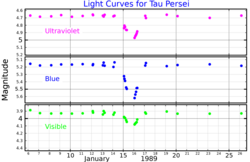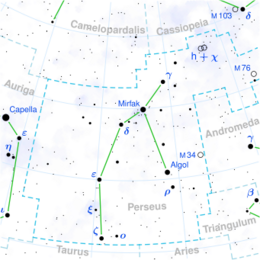Tau Persei
Topic: Astronomy
 From HandWiki - Reading time: 3 min
From HandWiki - Reading time: 3 min
Tau Persei (τ Per), also known as 18 Persei, is a binary star in the constellation of Perseus. The system is fairly close, and is located about 254 light-years (78 parsecs) away, based on its parallax.[1]

Tau Persei is an eclipsing binary, which means the two stellar components orbit each other in such an orientation that they periodically eclipse each other, while blocking the other's light. Unlike many eclipsing binaries that have short orbital periods, Tau Persei has an orbital period of 4.15 years. With a semi-major axis of 0.055 arcseconds,[5] this is one of the few eclipsing binaries whose components can be resolved with interferometry.[8]
The primary component of Tau Persei is a red giant with a spectral type of G8III. It has a radius 16 times that of the Sun, and is about 390 million years old.[6] Its companion is an A-type main-sequence star. In 1989, the primary star eclipsed the secondary, allowing for the stellar parameters to be derived via its light curve.[3]
Naming
In Chinese, 大陵 (Dà Líng), meaning Mausoleum, refers to an asterism consisting of τ Persei, 9 Persei, ι Persei, κ Persei, β Persei, ρ Persei, 16 Persei and 12 Persei. Consequently, the Chinese name for τ Persei itself is 大陵二 (Dà Líng èr, English: the Second Star of Mausoleum.).[9]
References
- ↑ 1.0 1.1 1.2 1.3 1.4 1.5 van Leeuwen, F. (2007). "Validation of the new Hipparcos reduction". Astronomy and Astrophysics 474 (2): 653–664. doi:10.1051/0004-6361:20078357. Bibcode: 2007A&A...474..653V. http://www.aanda.org/index.php?option=com_article&access=bibcode&Itemid=129&bibcode=2007A%2526A...474..653VFUL.
- ↑ 2.0 2.1 Samus, N. N. et al. (2009). "VizieR Online Data Catalog: General Catalogue of Variable Stars (Samus+ 2007-2013)". VizieR On-line Data Catalog: B/GCVS. Originally Published in: 2009yCat....102025S 1. Bibcode: 2009yCat....102025S.
- ↑ 3.00 3.01 3.02 3.03 3.04 3.05 3.06 3.07 3.08 3.09 3.10 3.11 3.12 3.13 Griffin, R. E. M.; Schroder, K. P.; Misch, A.; Griffin, R. F. (1992). "Optical Spectra of Zeta-Aurigae Binary Systems - Part Three - the 1989 Eclipse of Tau-Persei". Astronomy and Astrophysics 254: 289. Bibcode: 1992A&A...254..289G.
- ↑ Gontcharov, G. A. (2006). "Pulkovo Compilation of Radial Velocities for 35 495 Hipparcos stars in a common system". Astronomy Letters 32 (11): 759–771. doi:10.1134/S1063773706110065. Bibcode: 2006AstL...32..759G.
- ↑ 5.0 5.1 "Sixth Catalog of Orbits of Visual Binary Stars". United States Naval Observatory. http://www.usno.navy.mil/USNO/astrometry/optical-IR-prod/wds/orb6. Retrieved 4 April 2017.
- ↑ 6.0 6.1 6.2 6.3 6.4 6.5 6.6 6.7 Maldonado, J.; Villaver, E.; Eiroa, C. (2013). "The metallicity signature of evolved stars with planets". Astronomy & Astrophysics 554: 2013. doi:10.1051/0004-6361/201321082. Bibcode: 2013A&A...554A..84M.
- ↑ Schmidtke, Paul C.; Hopkins, Jeffrey L. (February 1990). "Photometry of the 1989 eclipse of τ Persei". Astrophysics and Space Science 164 (2): 323–328. doi:10.1007/BF00658833. Bibcode: 1990Ap&SS.164..323S. https://ui.adsabs.harvard.edu/abs/1990Ap&SS.164..323S. Retrieved 20 July 2022.
- ↑ McAlister, H. A. (1981). "Speckle interferometry of Tau Persei". The Astronomical Journal 86: 1397. doi:10.1086/113021. Bibcode: 1981AJ.....86.1397M.
- ↑ (in Chinese) AEEA (Activities of Exhibition and Education in Astronomy) 天文教育資訊網 2006 年 7 月 11 日
 |
 KSF
KSF
